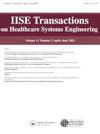急诊医疗系统中的医院选择与病人转运模式
IF 1.5
Q3 HEALTH CARE SCIENCES & SERVICES
IISE Transactions on Healthcare Systems Engineering
Pub Date : 2022-03-31
DOI:10.1080/24725579.2022.2053926
引用次数: 0
摘要
摘要我们设计了一个在急诊医疗系统中选择医院和运送病人的模型。该模型综合了文献中很少使用的保险范围标准和通常的标准,如护理能力、拥挤和邻近程度,这是混合卫生系统(公私)国家的典型标准。此外,该模型将急诊部门的旅行和等待时间视为一周中不同时段和天数的绩效指标。我们用Python编程语言开发并实现了一个原型,该原型连接到Google Maps API(Directions,Maps JavaScript)的web服务,以实时支持决策过程,并测试了其性能。这项研究用哥伦比亚一座城市紧急医疗系统管理的事件的实际数据验证了该模型。我们使用蒙特卡罗模拟来预测当前和提出的模型的旅行和转移时间(旅行时间 + 等待时间)。模拟结果表明,所提出的模型考虑了保险范围、急诊部门容量、拥挤和邻近性,使危重患者的生命处于危险之中的概率较低。此外,非危重患者的满意度随着等待时间的减少而增加。本文章由计算机程序翻译,如有差异,请以英文原文为准。
Hospital selection and patient transport model in the emergency medical system
Abstract We designed a model for hospital selection and patient transport in the emergency medical system. The model integrates the criterium of insurance coverage, seldom used in the literature and the usual criteria such as care capacities, congestion and proximity, typical of countries with mixed health systems (public-private). In addition, the model considered the travel and waiting times in emergency departments as performance measures in different time slots and days of the week. We developed and implemented a prototype in the Python programming language connecting to web services from Google Maps API (Directions, Maps JavaScript) to support the decision-making process in real-time and tested its performance. This research study validated the model with actual data from events managed by the emergency medical system in a Colombian city. We used Monte Carlo simulation to predict the current and proposed models’ travel and transfer time (travel time + waiting time). The simulation results indicate that the proposed model, which considers insurance coverage, emergency departments capacities, congestion and proximity, has a lower probability of putting at risk the lives of critically ill patients. In addition, non-critical patient satisfaction increases as wait times decrease.
求助全文
通过发布文献求助,成功后即可免费获取论文全文。
去求助
来源期刊

IISE Transactions on Healthcare Systems Engineering
Social Sciences-Safety Research
CiteScore
3.10
自引率
0.00%
发文量
19
期刊介绍:
IISE Transactions on Healthcare Systems Engineering aims to foster the healthcare systems community by publishing high quality papers that have a strong methodological focus and direct applicability to healthcare systems. Published quarterly, the journal supports research that explores: · Healthcare Operations Management · Medical Decision Making · Socio-Technical Systems Analysis related to healthcare · Quality Engineering · Healthcare Informatics · Healthcare Policy We are looking forward to accepting submissions that document the development and use of industrial and systems engineering tools and techniques including: · Healthcare operations research · Healthcare statistics · Healthcare information systems · Healthcare work measurement · Human factors/ergonomics applied to healthcare systems Research that explores the integration of these tools and techniques with those from other engineering and medical disciplines are also featured. We encourage the submission of clinical notes, or practice notes, to show the impact of contributions that will be published. We also encourage authors to collect an impact statement from their clinical partners to show the impact of research in the clinical practices.
 求助内容:
求助内容: 应助结果提醒方式:
应助结果提醒方式:


